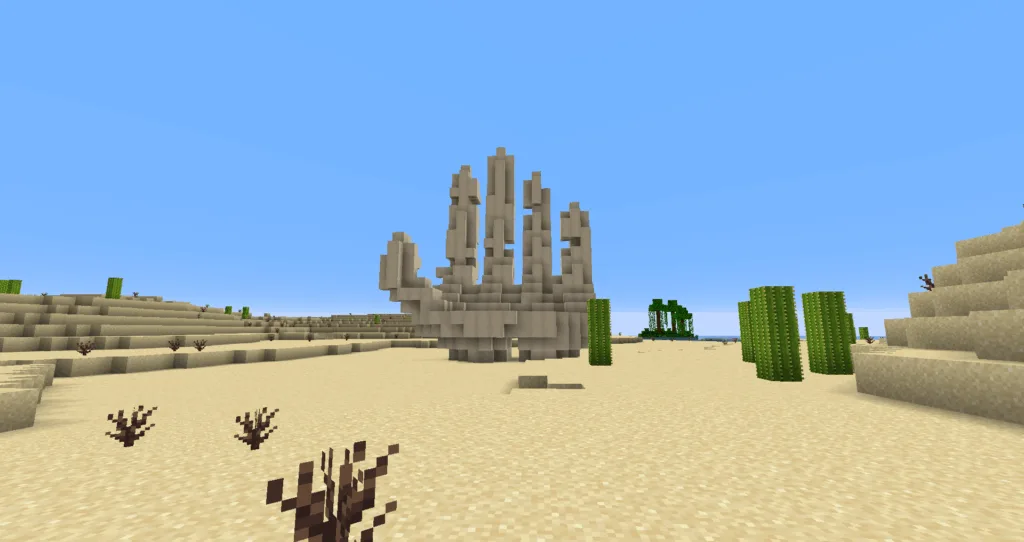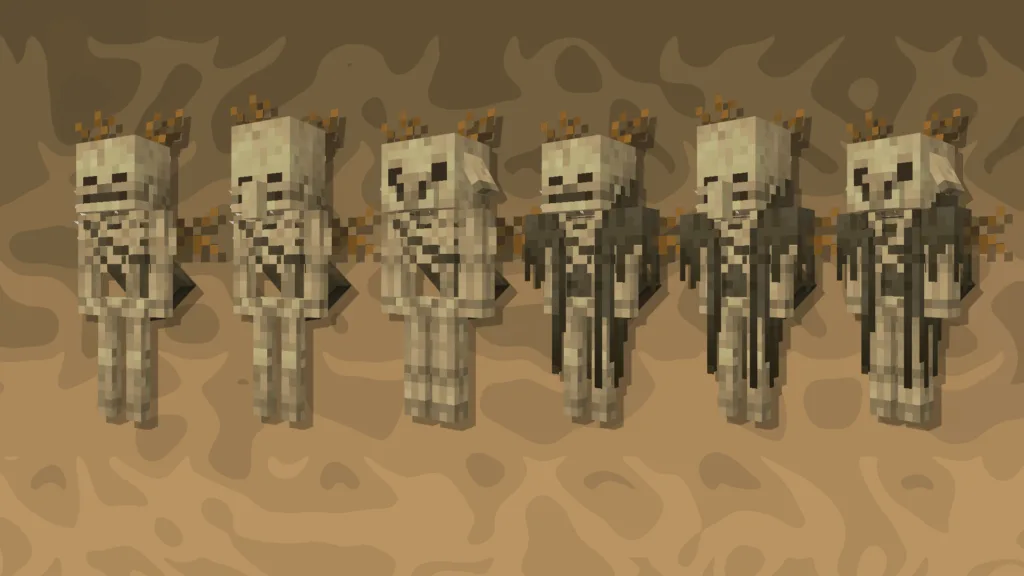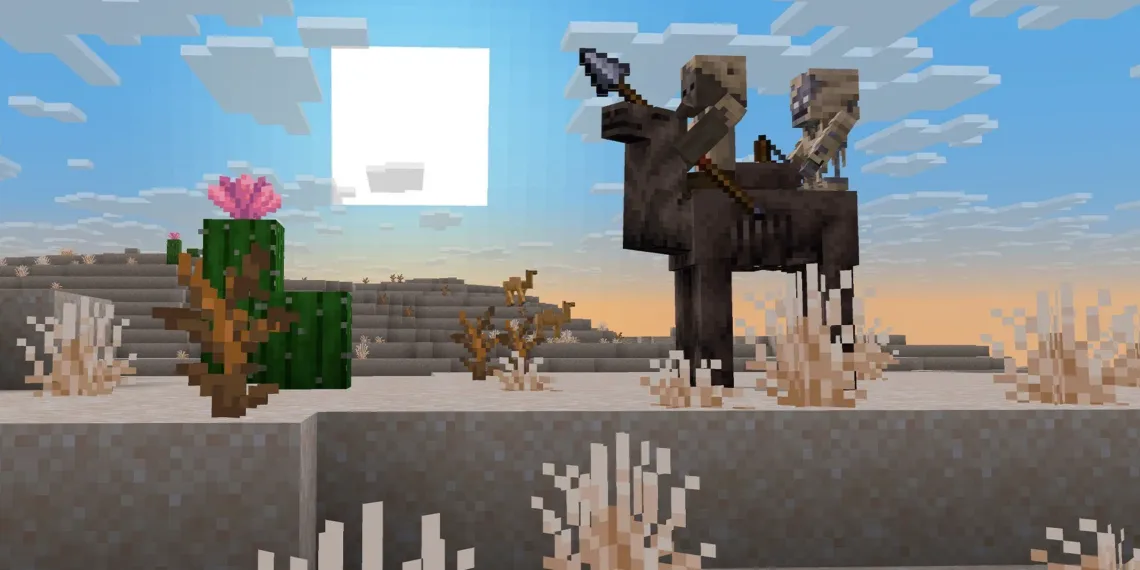Minecraft‘s deserts just got a dangerous upgrade. The Parched skeleton—arriving with the Winter 2025 Mounts of Mayhem game drop—transforms desert exploration from routine to risky. This sun-resistant archer shoots Weakness arrows, forcing players to rethink their combat strategies in one of the game’s most common biomes. Here’s your complete survival guide for this desiccated menace.
Table of Contents
Minecraft Parched Skeleton Reference
| Attribute | Details |
|---|---|
| Biome | Desert (surface only) |
| Spawn Condition | Light level 0 |
| Spawn Rate | Replaces some regular Skeletons |
| Sun Resistance | Does not burn (wears cloth) |
| Attack Type | Bow + Arrows of Weakness |
| Fire Rate | Slower than regular Skeletons |
| Drops | Bow, Arrows of Weakness |
| Cave Spawning | No (like Husks) |
| Release Date | Winter 2025 (Mounts of Mayhem) |
What Makes Parched Skeletons Unique?
The Parched skeleton joins the Bogged as Minecraft’s second new skeleton variant in recent updates, establishing a pattern of biome-specific undead variations that add tactical depth to exploration.

Desert Exclusivity: These sun-bleached archers spawn only on desert surfaces at light level 0, occasionally replacing standard Skeletons. You’ll encounter both variants during nighttime desert travels, creating unpredictable combat scenarios.
Sunlight Immunity: Unlike traditional Skeletons, the Parched’s tattered cloth head covering provides sun protection. This mechanic mirrors Husks, meaning deserts remain dangerous beyond dawn—a significant strategic shift for players used to waiting out the night.
No Cave Spawning: Following Husk rules, Parched Skeletons never spawn in caves beneath deserts, keeping them exclusively topside threats.
For comprehensive Minecraft combat strategies and mob guides, explore TechnoSports’ gaming section.
Combat Mechanics: The Weakness Factor
The Parched skeleton’s signature ability completely changes desert combat dynamics:
Infinite Weakness Arrows: Every shot applies the Weakness effect, reducing your melee damage by two full hearts. This debuff makes sword-rushing—a standard skeleton counter—significantly less effective.
Slower Fire Rate: Matching the Bogged’s deliberate shooting speed, Parched Skeletons fire less frequently than regular variants. This creates tactical windows for advancement between volleys.
Melee Vulnerability: While Weakness arrows discourage close combat, the reduced fire rate actually makes melee approaches more viable than against standard Skeletons—if you time your advances correctly.
According to Minecraft’s official Mounts of Mayhem announcement, these tactical variations encourage adaptive combat strategies rather than repetitive approaches.
Visual Design & Identification
Spotting Parched Skeletons before engagement is crucial:
Darker Coloration: Significantly darker bone structure than regular Skeletons, resembling sun-bleached remains.
Glowing Eyes: Distinctive eye glow helps identification at distance during nighttime encounters.
Tattered Clothing: Worn, dilapidated cloth similar to Husk attire—both thematic and functional for sun protection.
Husk Aesthetic: Overall appearance mirrors desert-adapted Zombie Husks, maintaining biome-specific design consistency.

Survival Strategies Against Parched Skeletons
Ranged Superiority: Bows, crossbows, or tridents eliminate threats before Weakness application. Maintain distance and match their archery tactics.
Shield Blocking: Shields negate both arrow damage and Weakness effects. Advance with shield raised, attacking during their slower reload windows.
Environmental Cover: Desert terrain offers limited natural cover, but pillaring or digging temporary trenches provides protection while you heal or strategize.
Armor Enchantments: Protection enchantments reduce arrow damage, while Projectile Protection specifically counters their primary attack method.
For more Minecraft survival tips and building tutorials, visit TechnoSports’ complete gaming hub.
Testing Parched Skeletons in Snapshot 25w44a
Experience this new mob before the Winter release:
- Open Minecraft Launcher and select Java Edition
- Click the dropdown beside the Play button
- Select “Latest Snapshot” (currently 25w44a)
- Create a new world or load an existing desert area
- Wait for nighttime and explore desert surfaces
Remember: Snapshots are experimental versions. Back up worlds before testing, and expect potential bugs or balance changes before official release.
Visit Minecraft’s official snapshot page for complete patch notes and technical details.
The Bigger Picture: Mounts of Mayhem
The Parched skeleton represents just one element of the larger Mounts of Mayhem game drop. Combined with Undead Camels carrying spear-wielding Husks, desert biomes are transforming into genuine combat challenges requiring preparation and strategy.
This shift aligns with Mojang’s goal of making established biomes feel fresh and dangerous, rewarding experienced players with new tactical puzzles while maintaining accessibility for newcomers.
Frequently Asked Questions
What items do Parched Skeletons drop in Minecraft’s Mounts of Mayhem update?
Parched Skeletons drop bows and Arrows of Weakness upon death. Unlike regular Skeletons that drop standard arrows, Parched variants provide access to infinite Weakness arrows through mob farming—valuable for PvP scenarios, adventure maps, or automated potion ingredient collection. The drop rates follow standard Skeleton mechanics, with better chances when using Looting enchantments. This makes Parched Skeleton farms potentially more valuable than regular Skeleton farms for specific gameplay applications.
Do Parched Skeletons spawn in desert villages or only in open desert areas?
Parched Skeletons spawn anywhere in desert biomes meeting light level 0 requirements on surface blocks, including desert villages. However, they don’t spawn in caves beneath deserts, following Husk spawning rules. Village spawning means nighttime village raids and defense become more complex, as Weakness arrows debuff your melee damage during Pillager raids or Zombie sieges. Well-lit villages prevent spawning, making proper lighting even more critical in desert settlements.








